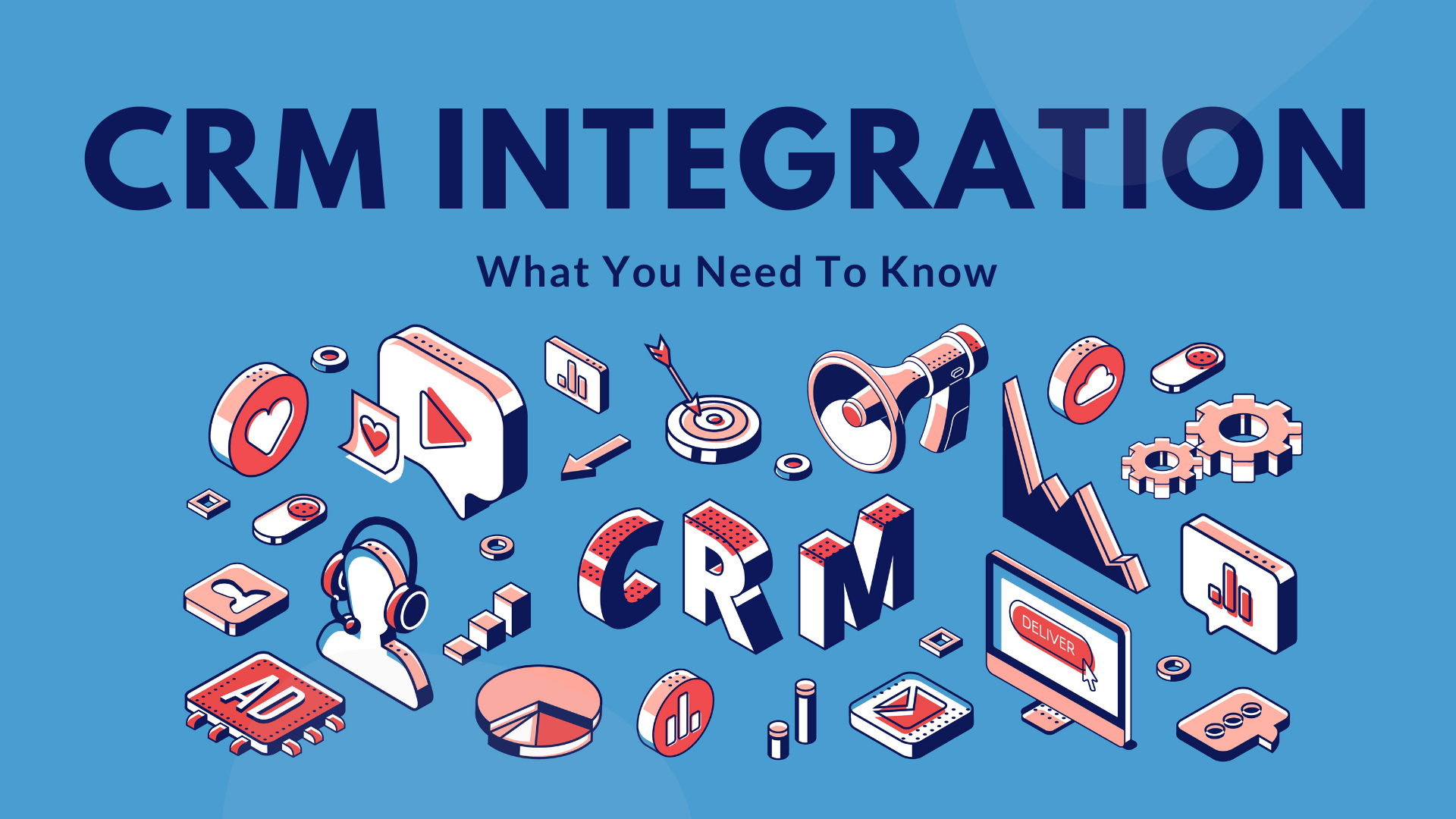Many of us use integrations that are built right into our personal computing software and smartphones. Phone numbers can be easily synced between address books, flights and appointments can be automatically added to our calendar, or our Instagram photos can be made to post on Twitter and Facebook too.
But when it comes to CRMs, many businesses don’t take the time to set up integrations with their CRM software. Not only can it save you the time and trouble of managing your data manually, but it ensures that your tools are working together efficiently.
Fortunately, many CRMs are designed with integrations in mind, from widely-used apps like G Suite to more specialized sales tools like those in the Intercom marketplace.
What is CRM Integration?
So, what exactly is a CRM integration? In short, it refers to any tool that can be directly connected to your CRM software, allowing you to handle more functions using a single interface, rather than having to switch between apps.
Integrations can be either:
- native, or built into the software itself
- 3rd-party, designed by external developers
- or custom-built using APIs, or application program interfaces
An integration can be as simple as connecting your CRM to your calendar so you don’t double-book meetings, to adding a widget to your website that automatically creates a record for every new prospect who fills out a webform.
While CRM integrations can streamline your sales pipeline, they’re even more useful if you have multiple teams interacting with the same customers over time. For example, you can view everything from a customer’s purchase history to their support tickets in the same CRM software -- what’s known as single customer view.
Just imagine trying to access all of this data without CRM integrations: your CRM may have their contact details, but their sales data is in a point-of-sale system like Square, and they sent a DM to your support team on Twitter instead of calling you up.
Keeping track of all of these points of contact is one of the biggest challenges SaaS businesses and inside sales teams can face.
With CRM integrations, you can bring all of this information into one place, using your CRM as a hub for all of your customer data.
You can either use point-to-point integration -- in which each third-party app is linked separately -- or you can build overarching integrations that use custom code.
The more integrations you have, the more important it is to create a holistic software system to reduce complexity and cut down on single points of failure.
With a CRM like OnCourse, you can use built-in integrations with core G Suite apps, or tailor it to your unique business needs using the customization settings.
Either way, the OnCourse team will help with your initial setup, making it easy to figure out which integrations to incorporate into your software.
CRM integration can be a game-changer for your business.
What’s great about integrations is that you can pick and choose the ones that work best for your business. Whether you want to automate marketing tasks, improve your social media strategy, or build a chatbot for your website, there’s likely an integration for it.
CRM integrations can help break down internal data silos, ensuring that every one of your team members has access to the data they need, when they need it.
Remember, your CRM is only as as good as the data you feed into it. Using the right integrations can make your CRM more useful and relevant to all of your teams.
From an improved customer service experience, to more useful business intelligence insights, integrations can help you use your CRM to its full capabilities.
Some integrations are built right into the software, while others require you to download them from a third-party marketplace. Either way, the number of tasks you can automate using CRM integrations is virtually unlimited.
And most importantly, integrations don’t necessarily require you to learn a new tool. In many cases, you’ll be able to connect your CRM to software that your team is already using -- such as Evernote or Mailchimp.
If your team has been reluctant to adopt a new CRM, or simply isn’t using yours to its full potential, showing them how to integrate some of their most frequently used tools may be just what you need to get them on board with it.
Think of integrations as a “bridge” between your existing tools and your comprehensive CRM software, reducing the learning curve and speeding up user adoption.
Some CRM integrations are absolute must-haves.
Now, which integrations should you be sure to make available for your team? Are there any must-have integrations that are simply indispensable? Let’s take a look at some of the most popular CRM integrations out there and why they’re so useful.
Email Integration

A few of the most important integrations -- which are built into many CRMs -- are email and calendar integrations. Whether you use Gmail or Outlook, you can link your email client with your software so you can send and receive emails right in your CRM.
This is important for keeping track of interactions with your contacts. You can click on the header to see if you’ve interacted with them before, and if not, decide if they’re a lead, customer, or another type of contact.
What if you’re on the go, and want to reply to a work email from your smartphone? An integration can help you there too, by pulling contact data out of your CRM.
That’s right: not only will you have access to your email client in your CRM, you’ll also have access to the resources of your CRM right in your inbox.
The most useful integrations offer a two-way sync, keeping track of both incoming and outgoing emails, and automatically adding them to your customer record.
Calendar Integration
The second most important CRM integration is with your calendar. Once again, you can link your Google or Outlook calendar to your CRM with two-way integration tools.
Automatically add events to your work calendar to prevent scheduling mishaps, or let your clients view your availability and request a callback at a specific time.
You can also use these integrations to schedule work meetings, send out invites and reminders, and log meeting notes.
Plus, you can get reminders directly in your calendar when it’s time to follow-up with a prospect, and keep track of how long it’s been since you last spoke to them.
Cut down on double bookings and missed opportunities -- as well as the complexity of juggling multiple calendars -- with this must-have CRM integration.
Marketing and Support Integrations
Another great way to use CRM integrations is for marketing automation, which includes everything from lead management to analytics.
If you’re already using an email marketing tool like Mailchimp, then you can integrate it with your CRM to make it even more powerful.
Use marketing automation tools to start a drip campaign at exactly the right time, track the open and click-through rates of your emails, and more.
You can also automatically import data you collect from webforms and survey tools like SurveyMonkey, cutting down on manual data entry.
Other options include creating a chatbot to greet visitors to your website or Facebook page, or building a knowledge base integration right inside your CRM.
Chatbots can answer common questions that don’t require a live agent, while a built-in knowledge base lets your team send help content to customers with one click.
Not only that, but your team can see which articles they’ve already viewed, making it easy to troubleshoot problems and optimize the content in your knowledge base!
Your marketing and support teams will have less busywork to do -- and more ways to work together -- with automated integrations like these.
Social Media Integration
Social media has become an increasingly important channel of communication when it comes to marketing and customer support.

These days, customers are just as likely to send you a Facebook message or a Twitter DM as they are to fill out a support request or call up a helpline.
And they expect you to remember every interaction they’ve had with your brand -- good or bad -- from Twitter mentions to Instagram posts. That’s a lot to ask!
With social media integrations, you can keep track of those interactions as easily as you do emails. You can automatically turn DMs into support tickets, and view a user’s social media profiles from directly within your CRM.
Keep track of who shares what, and reach out to the right users to create an influencer campaign. Or, use the LinkedIn Sales Navigator to prospect for B2B leads.
From building customer profiles, to scheduling posts on popular platforms, social media integrations take your CRM capabilities to a whole new level.
Internal Communications
Not all CRM integrations are designed for customer-facing interactions. Some tools are great for internal communications too.
Many CRMs offer Slack integrations, so you don’t have to leave your favorite channel to get updates on new leads and keep track of your pipeline.
Use @ mentions to draw colleagues into a conversation in either Slack or your CRM, so that everyone’s in the loop without having to switch between the two.
In addition to chats, you can use integrations for more formal documents that need to be shared or signed by colleagues or clients.
PandaDoc allows you to design contracts, quotes, proposals, and other documents with data from your CRM. Use existing data to fill out your documents, then sync and save in your CRM when they’re returned - no printers needed.
Some CRMs can even sync with Quickbooks or Paypal to send invoices, issue refunds, and keep track of any other merchant transactions.
Sales Dialers
Finally, one of the most important integrations for a sales team is an in-app dialer, which you can find built into many CRMs such as OnCourse.
This tool allows you to receive reminders to call a prospect, preview their profile before you call, log and record your calls, and leave a voicemail if no one answers.
Some CRMs have predictive dialers, cutting down on the amount of time between calls, while other integrations allow you to schedule conference calls and video chats.
If your business relies on inbound calls, you can use a widget like CallPage to prompt visitors to your website to leave a callback number.
Or, use CallRail to find out where your calls are coming from, and which ad campaigns and PPC keywords drive the most leads to your phone.

You also need to find the right CRM for the job.
From marketing to analytics, CRM integrations can open up a whole world of affordable tools that can add more flexibility and capability to your software.
And we haven’t even gotten into more complex integrations, such as e-commerce tools like Shopify, or event integrations platforms like Eventbrite. Whatever tasks you want to streamline, there’s bound to be an integration for it out there.
But that doesn’t mean that all CRMs are interchangeable. Each CRM has its own set of native integrations and third-party integrations that it’s compatible with.
And while you can develop your own custom integrations using APIs, that requires a bit more technical know-how and may not be an option for all teams.
So before you invest in a CRM, do some research and find the one that’s the right fit. A sales team may need a different CRM than a team of social media marketers.
How OnCourse Can Help
For a comprehensive all-in-one CRM with dozens of integrations, check out OnCourse, which offers marketing automation tools, an in-app sales dialer, and more.
OnCourse integrates with core apps like Outlook, Gmail, and Google Calendar, to make it easy to schedule calls, send SMS messages, and automate email campaigns.
Since it’s cloud-based, your team members can access it from anywhere, and it doesn’t require additional servers or a complicated setup.
In addition, you can customize many aspects of the CRM using the admin interface, so that different members of your team can be granted different permissions.
Don’t be limited by the tools you have now. Reach out to the team at OnCourse today to find out how you can build the integrations you need into your CRM software.

